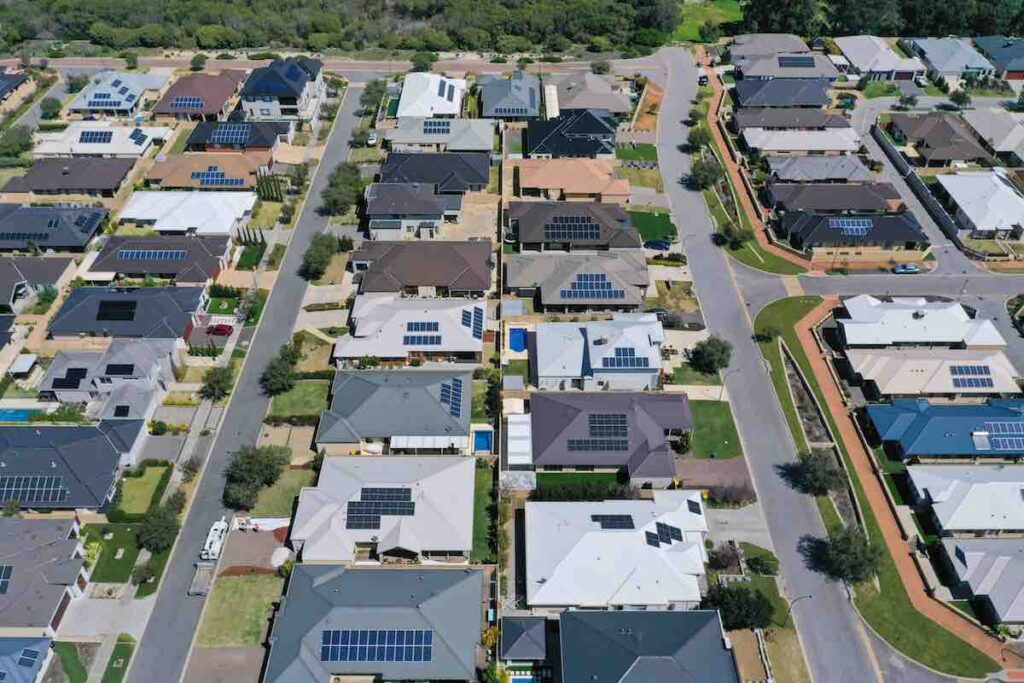New South Wales (NSW) continues to embrace solar energy as a sustainable solution to rising electricity costs and environmental concerns. With advancements in solar technology and government incentives, homeowners across the state are adopting renewable energy at impressive rates. Among the top-performing areas, five suburbs stand out due to their exceptional solar energy adoption rates. Let’s dive into the details and explore what makes these suburbs leaders in solar power.

1. Rouse Hill (2155) – 85,953 kW
Rouse Hill takes the top spot with a staggering 85,953 kW of installed solar capacity. This growth can be attributed to the suburb’s modern developments and a high percentage of new homes with rooftop solar systems. The community in Rouse Hill values energy efficiency and has embraced solar as a way to reduce electricity bills while contributing to a cleaner environment.
Residents also benefit from generous government rebates, making the initial investment in solar systems more affordable. With sunny weather most of the year, the suburb offers ideal conditions for solar energy production.
2. Liverpool (2170) – 85,063 kW
Closely following Rouse Hill, Liverpool has recorded 85,063 kW of solar capacity. The area’s diverse population and expanding residential developments have driven the demand for renewable energy solutions.
One key factor in Liverpool’s success is its large number of freestanding homes with ample rooftop space, which is ideal for solar panel installations. Additionally, solar providers in the area offer competitive pricing, making solar an attractive choice for homeowners.
3. Blacktown (2148) – 51,258 kW
Blacktown has emerged as a solar powerhouse, with 51,258 kW of installed capacity. This western Sydney suburb has consistently ranked high in solar adoption due to its mix of affordability and community awareness about renewable energy benefits.
Many households in Blacktown opt for mid-sized systems that balance upfront costs with long-term savings. Local initiatives promoting sustainability and energy efficiency have also contributed to the area’s impressive numbers.
4. Baulkham Hills (2153) – 51,180 kW
Baulkham Hills, with 51,180 kW of solar installations, reflects the rising trend of renewable energy adoption in affluent suburbs. Residents in this area often prioritise energy independence, using larger systems equipped with battery storage to maximise savings.
The community’s commitment to sustainability and the availability of solar incentives have made Baulkham Hills a shining example of how solar energy can thrive in urban settings. Transitioning to renewable energy sources has become a key focus for many households here.
5. Penrith (2747) – 48,283 kW
Rounding out the list is Penrith, with 48,283 kW of solar capacity. Known for its sunny weather, Penrith provides perfect conditions for solar energy production year-round.
Homeowners in Penrith often highlight solar as a way to combat rising energy costs, particularly during the hot summer months when air conditioning drives up electricity bills. The suburb’s strong solar uptake reflects its residents’ desire for financial and environmental sustainability.

Why These Suburbs Lead in Solar Adoption
Several factors contribute to the solar success of these suburbs:
- Government Incentives: Rebates and incentives under the Small-scale Renewable Energy Scheme (SRES) lower the cost of solar installations, encouraging widespread adoption.
- NSW Battery Incentive: From 1 November 2024, the NSW Government’s Peak Demand Reduction Scheme offers solar battery rebates. Eligible homes and businesses can save $1,600–$2,400 on battery installation costs and claim $250–$400 for connecting to a Virtual Power Plant. Check here for more information.
- Rising Electricity Prices: Many households are turning to solar as a cost-effective alternative to grid electricity.
- Environmental Awareness: With growing concern about climate change, these communities are taking proactive steps to reduce their carbon footprints.
Additionally, the availability of competitive solar providers ensures that homeowners in these areas receive tailored solutions that suit their energy needs and budgets.
The Benefits of Going Solar
Switching to solar offers numerous advantages for households in these leading suburbs. Key benefits include:
- Reduced Energy Costs: Solar systems significantly lower electricity bills, with savings increasing over time.
- Increased Property Value: Homes with solar installations are often more attractive to buyers.
- Energy Independence: Paired with battery storage, solar panels allow households to store excess energy for later use, reducing reliance on the grid.
Moreover, with solar panel prices continuing to decline, the financial barrier to entry has become much lower. This affordability has contributed to the growing adoption rates across NSW.
Future Trends in Solar Adoption
The success of these top suburbs highlights the broader trend of renewable energy adoption across NSW. As solar technology improves and battery storage becomes more accessible, more households will likely follow suit.
Additionally, government policies such as the phase-out of the solar rebate by 2030 are encouraging homeowners to act sooner rather than later. By installing solar systems now, residents can maximise their rebate and enjoy substantial savings before incentives decrease.
Final Thoughts
The top suburbs for solar in NSW, including Rouse Hill, Liverpool, Blacktown, Baulkham Hills, and Penrith, serve as inspiring examples of how communities can embrace renewable energy. By adopting solar power, these areas are reducing their carbon footprints, lowering energy costs, and contributing to a sustainable future.
If you’re considering solar for your home, there’s no better time to make the switch. With the right system, you can join these leading suburbs in harnessing the power of the sun and reaping its long-term benefits.